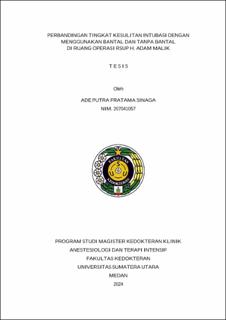Perbandingan Tingkat Kesulitan Intubasi dengan Menggunakan Bantal dan tanpa Bantal di Ruang Operasi RSUP H Adam Malik
Correlation Analysis of Lemon, IDS, and WILSON Scores in Assessingintubation Difficulty in Patients Undergoing General Anesthesia

Date
2024Author
Sinaga, Ade Putra Fratama
Advisor(s)
Hamdi, Tasrif
Tanjung, Qadri F
Metadata
Show full item recordAbstract
Introduction: Intubation is a crucial maneuver performed during anesthesia procedures. The act of intubating with an endotracheal tube is a definitive airway management technique that provides maximal protection against the occurrence of aspiration of stomach contents or fluids. Endotracheal intubation is a rapid, simple, and safe non-operative technique that facilitates all objectives of airway management. Several studies indicate that the proper positioning of the head and neck is one of the most important steps in laryngoscopy and tracheal intubation. Some studies recommend the use of a head pillow to improve the laryngoscopic view by enhancing the occipito- atlanto-axial angle and enlarging the submandibular space.
Methods: The design of this study was a randomized cross-sectional study with two research groups conducted at Haji Adam Malik General Hospital Medan (RSUP HAM) to compare the difficulty levels of intubation using the technique with and without a pillow.
Results: In this study, the average age + SD for the group without a pillow was approximately
49.4 ± 12.1 years, and for the group with a pillow, it was approximately 44.3 ± 14.4 years. The majority of subjects in the group without a pillow were male (7 subjects), while in the group with a pillow, the majority were female (7 subjects). The BMI distribution for group 1 had an average + SD of 21.0 ± 1.65 kg/m², and group 2 had an average + SD of 21.8 ± 1.85 kg/m². The ASA distribution in the group without a pillow was mainly ASA 1, whereas in the group with a pillow, both ASA 1 and ASA 2 had the same frequency. However, no significant difference was found between the two groups. According to the Wilson score for predicting difficult intubation, most research subjects were predicted to have easy and not too difficult intubations in both groups, with and without a pillow. Patients without a pillow often required a little assistance during intubation, while the majority of patients using a pillow were easily intubated. However, no significant difference was found between the two groups (p>0.05). Patients intubated without a pillow had an average score of 15.9±1.6, while those intubated with a pillow had an average score of 10.8±1.8, showing a significant difference between the two groups (p<0.05). Using the Cormack-Lehane score, most patients without a pillow were at grade 2, while the majority of patients with a pillow were at grade 1. A significant difference was found between the two groups (p<0.05).
Conclusion: Patients intubated without a pillow often required a little assistance, while the majority of patients intubated with a pillow were easily intubated; however, no significant difference was found between the two groups (p>0.05).
